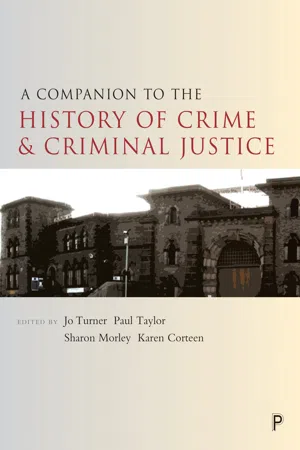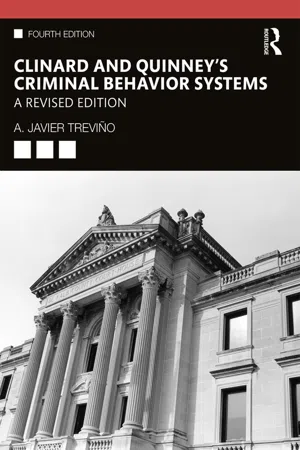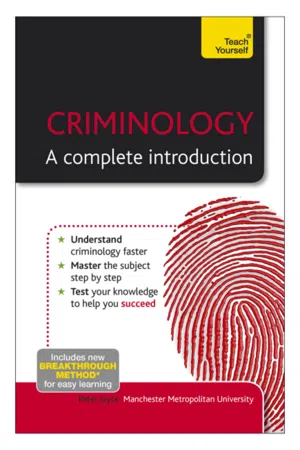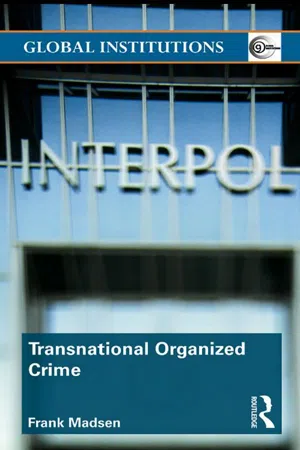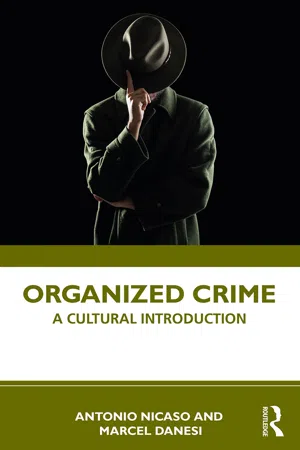American Organized Crime
American organized crime refers to the coordinated criminal activities of groups or syndicates operating within the United States. It has been historically associated with activities such as bootlegging, gambling, drug trafficking, and extortion. Notable organized crime groups in American history include the Italian Mafia, Irish Mob, and various street gangs, which have had a significant impact on the country's social and economic landscape.
7 Key excerpts on "American Organized Crime"
- Turner, Jo, Taylor, Paul(Authors)
- 2017(Publication Date)
- Policy Press(Publisher)
...(2011) Crime and society in twentieth-century England. Harlow: Pearson Education. Gambetta, D. (1996) The Sicilian mafia: The business of private protection. Cambridge: Harvard University Press. McIntosh, M. (1975) The organisation of crime. London: Macmillan Press. Smith, D.C. (1976) ‘Mafia: the prototypical alien conspiracy’, The Annals of the American Academy of Political and Social Science, 423: 75–88. Wright, A. (2006) Organized crime. Cullompton: Willan Publishing. ORGANISED CRIME (UNITED STATES OF AMERICA) In the popular imagination, ‘organised crime’ in the US is synonymous with the Mafia, the Mob or La Cosa Nostra, a secretive criminal organisation, usually composed of White ethnics, particularly Italian-Americans, bound by codes of silence, intimidation and violence, which profits from the manufacture, sale, distribution or trafficking of banned substances, as well as labour racketeering, construction and municipal services such as garbage collection. There is no single definition of organised crime, and in the early 21st century, the term covers: street, motorcycle and prison gangs; local, state and regional crime syndicates; domestic and international cartels; and transnational crime-terrorism alliances. To ensure longevity, groups are highly adaptive as they take advantage of changing economic opportunities, or respond to new external political, crime control and national security initiatives. No single ethnic group has monopolised criminal activity, though gangs with strong ethnic ties were common in the 19th and early 20th centuries. There were frequent confrontations between the Irish Dead Rabbits and Five Point Gangs, the native-born Bowery Boys, and the New York Police in the 1840s and 1850s, as post-famine immigration swelled the ranks of Irish youth gangs and heightened nativist violence...
- eBook - ePub
Clinard and Quinney's Criminal Behavior Systems
A Revised Edition
- A. Javier Treviño(Author)
- 2019(Publication Date)
- Routledge(Publisher)
...7 ORGANIZED CRIME Although most people have heard about organized crime, few understand its workings, structures, personnel, or networks. Nor do they generally comprehend its extent or the threat it poses to a society’s economic and national security. It is variously perceived as sinister, secretive, terrifying, romantic, fascinating, and even necessary. Over the years it has provided the subject matter for popular culture. Not only in the United States and other industrialized countries but in developing countries as well, organized crime is mythologized as an exotic, simultaneously attractive, and repellant phenomenon. It is found around the globe, from China to the United States, Italy, Serbia, Mexico, Nigeria, Japan, Russia, and more. Organized crime has been referred to as a business enterprise organized for the rational purpose of generating economic gain through illegal activities. 1 Another definition is that, [o]rganized crime is a continuing criminal enterprise that rationally works to profit from illicit activities that are often in great public demand. Its continuing existence is maintained through the use of force, threats, monopoly control, and/or the corruption of public officials. 2 Just as in legitimate corporate organizations, organized crime provides (albeit illegally) needed—or at least desired—goods and services including gambling, loansharking, narcotics, money laundering, commercial sex, and other forms of vice. Until the mid-1980s organized crime was chiefly identified with Italian American Organized Crime—also referred to as “traditional” organized crime, the Mafia, or La Cosa Nostra (“Our Thing”)...
- Peter Joyce, Wendy Laverick(Authors)
- 2013(Publication Date)
- Teach Yourself(Publisher)
...In the USA, for example, President Johnson’s Commission on Law Enforcement and Administration of Justice (1967) and President Reagan’s Commission on Organized Crime (1983) examined the nature of the problem. (Both subsequently attributed much of the problem to the Mafia.) In Italy, vigorous measures to combat the Sicilian Mafia and the Neapolitan Camorra (which included the use of the military) were undertaken towards the end of the twentieth century. In the UK concerns regarding organized crime resulted in the creation in 2005 of a national police organization (the Serious Organized Crime Agency). This was replaced in 2013 by the National Crime Agency. As many contemporary forms of organized crime are international in nature, initiatives to tackle it have entailed co-operation between countries in the areas of policing and law enforcement. We will consider initiatives of this nature more fully in the next chapter. The importance of these initiatives is emphasized by a trend affecting organized crime whereby organized criminal groups may co-operate with each other, raising the potential of more serious forms of criminal activity being committed. Links between traditional organized crime groups in Italy and Latin America and newer bodies such as the Russian ‘Mafia’ are an example of this. Dig deeper Antonopoulos, G. and Papanicolaou, G. (2018). Organised Crime: A Very Short Introduction. Oxford: Oxford University Press. Morton, J. (2003). Gangland. London: Time Warner. Obokata, T. and Payne, B. (2016). Transnational Organised Crime: A Transnational Analysis. London: Routledge. Wright, A. (2006). Organised Crime. Cullompton, Devon: Willan Publishing. Fact-check 1 In the USA, organized crime developed significantly during the Prohibition Era...
- eBook - ePub
- Frank Madsen(Author)
- 2009(Publication Date)
- Routledge(Publisher)
...Nevertheless, the following points need to be made: (i) Basically all criminalization by bi- or multilateral agreements or international prohibition regimes is the promotion and international codification of norms generated in the Occident and in particular in the United States. (ii) NGOs and other transnational moral entrepreneurs promote and export norm sets based on ethical considerations without clarifying whose ethics they are promoting and without explicating why that particular set of norms is superior to other sets of norms and deserves to be internationally accepted. The concept of organized crime The concept of organized crime was born in the United States in the nineteenth century; nevertheless, there has been little agreement throughout history as to the contents of the concept. The two criminologists, Goldthaite Dorr and Sidney Simpson, 4 claimed in their 1929 publication that organized crime consists in two activities, criminal fraud and the protection racket, thus concentrating on the behavioral aspect of organized crime instead of on racial and ethnic aspects. Unfortunately, the U.S. government, and a large part of scholarship, did not follow this advice, but concentrated on a perceived collective identity rather than on behavioral characteristics. There seems to be little doubt that such an approach by the U.S. government was much influenced by the then-recent St. Valentine’s Day Massacre in 1929 in Chicago, in the course of which a crime group of Italian origin, under the leadership of the later rather notorious criminal Al Capone, killed seven members of a rival group of Irish origin in what appeared to be an execution; this event quite understandably caused a public outcry. 5 The perceptual outcome was based on a view of organized crime as a closed ethnic group, often of Italian origin, based on tribal or family relationships, etc...
- eBook - ePub
The New Technology of Financial Crime
New Crime Commission Technology, New Victims, New Offenders, and New Strategies for Prevention and Control
- Donald Rebovich, James M. Byrne, Donald Rebovich, James M. Byrne(Authors)
- 2022(Publication Date)
- Routledge(Publisher)
...Attorney’s Offices, under the supervision of the Department of Justice, are inclusive in the cases they consider part of the organized crime problem. These cases deal with both traditional and non-traditional organized criminal groups, as well as illegal drug trafficking prosecutions. Federal prosecutions focus particularly on the importation of illegal narcotics, interstate, large-scale or organized drug trafficking, or individuals or groups that use violence in the course of drug dealing, as well as other kinds of illegal or banned goods (U.S. Department of Justice, 2020). State and local jurisdictions prosecute the vast majority of drug offenders, so the U.S. Attorney’s Offices focus their efforts on interstate, international, organized crime offenders, and cases involving the diversion of prescription drugs for illegal sale. Therefore, prosecutions of organized crime in the US are generated by both organized crime group activity, as well as by the nature of crimes committed (organized trafficking in illicit goods and services). The literature Organized crime has a folklore and mythology surrounding it, involving ethnicity, national origin, trafficking illicitly in goods and services, and extortion threats (Albini & McIllwain, 2013 ; Catino, 2019 ; Finckenauer, 2007 ; Nicaso & Danesi, 2017 ; Viano et al., 2004). These are terms not associated with white-collar crime or financial crimes in general, even though organized crime has the same objective of financial gain. There has been much discussion and debate about the true nature and status of organized crime. Are organized crime activities shifting more toward economic crimes, such as cybercrime and fraud, or does it remain focused on illicit trafficking of goods and services? There are multiple known cases of transnational frauds committed by criminal groups or networks, but it has not been determined whether this is typical or aberrant behavior in the world of organized crime...
- eBook - ePub
Organized Crime
A Cultural Introduction
- Antonio Nicaso, Marcel Danesi(Authors)
- 2021(Publication Date)
- Routledge(Publisher)
...Chapter 1 What is organized crime? Introduction Thanks to Hollywood and television characters like Tony Soprano, the American Mafia (also called Cosa Nostra) is probably the world’s best-known organized crime group, but there are plenty of others, which have also been the subject of movies and TV shows, albeit to a lesser extent. Why the fascination? This question will be broached throughout the subsequent chapters of this book. Here, we will address a different but related one: What is organized crime? All organized criminal groups (henceforward abbreviated to OCs) have a similar kind of organizational structure, even though they may speak different languages and emanate from vastly different cultural environments. They all have codes of conduct and specific symbols, rituals, and modes of in-group communication that they have created to set themselves apart from the mainstream world and to generate a sense of in-group meaning that gives them purpose and identity. OCs are self-styled cultural enclaves from which members draw their inspiration, pride, and sense of belonging based on the very codes and symbols that have been concocted to distinguish the OCs from everyone else. There are many OCs that fit this characterization, from street gangs such as the Norteños in California to the Mafia in Sicily, from outlaw motorcycle gangs like the Hells Angels to drug cartels, such as the Sinaloa one. One way to classify them distinctively is according to whether they have existed for a considerable period of time or have emerged in more recent times. The former can be called traditional, classical, or historical, and the latter neophyte or emergent. There are also gangs that are offshoots of the traditional ones, such as the American Cosa Nostra, which is a derivative of the original Italian Mafia gangs, developing a separate identity in America, as will be discussed subsequently...
- eBook - ePub
Global Organized Crime
A 21st Century Approach
- Mitchel P. Roth(Author)
- 2017(Publication Date)
- Routledge(Publisher)
...Chapter 5 Historical roots of organized crime in America Key Terms Five Points Jacob Riis Gangs of New York Tammany Hall Whyos Monk Eastman Arnold Rothstein Al Capone City boss Boss Tweed Mike McDonald Chicago Outfit Mont Tennes Jim Colosimo John Torrio Political patronage Sam Giancana Angelo Bruno Raymond Patriarca Whitey Bulger and the Winter Hill Gang Jack Dragna Mickey Mouse Mafia Mickey Cohen Purple Gang Mayfield Road Mob Cigar City Santo Trafficante, Sr. Santo Trafficante, Jr. Immigrants have long been viewed as the source of America’s crime problem. During the colonial era before American independence, the crime problem was blamed on England’s transportation system which sent convicted criminals and vagrants to the New World. The waves of Irish and German immigrants that arrived during the early 19th century only heightened this fear of foreigners. This theme continues to resonate in the United States during the 2015–2016 presidential campaign as the debate over immigration became increasingly vitriolic, with eventual Republican President-elect Donald Trump making unsubstantiated claims that many immigrants are criminals and that Mexico is “not sending their best” immigrants to America (Lee 2015). No matter where they came from, early immigrants were usually short on funds but often made up for it with determination to succeed. As social scientists have demonstrated, criminal activity was often a consequence of the immigration experience, that is, until the social and environmental causes of crime were eliminated. For most of the 19th century the Irish dominated New York City’s Lower East Side. During the 1830s and 1840s they were joined by growing numbers of Polish, Dutch, and German Jews, as well as Italians. A large number of German Jews fled to America after the failed 1848 revolution and the political repression that followed. Between 1850 and 1860 immigrants made up half of its estimated one million inhabitants...
